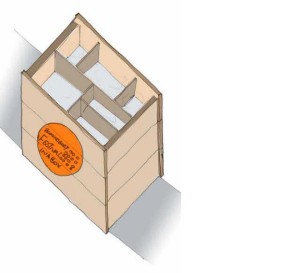Boxes have a history within dementia research and memory activities. Some very important work in the field of arts and health has come about through the production of ‘memory boxes’, for example. Via the work of the European Reminiscence Network or the ‘House of Memories’ programme at the Museum of Liverpool (to name only a couple of examples), the therapeutic benefits of assembling personal boxes of meaningful objects, photographs, etc, for people with dementia has been well established. As our weekly visits get under way in earnest, using our first Festival in a Box (designed by architects Lyn Atelier), I want to reflect in this post on not only on our box, but on ‘boxes’, or ‘the box’, as a concept.
In no particular order, therefore, here are some of my thoughts on the status of the box as a ‘symbolic object’, or on what we might loosely call the ‘phenomenology’ of boxes.
Boxes and Festivals –
A box is a receptacle for storage. It is what we use for safe handling and transport, a means of protecting something precious. It is an object that exists primarily to protect something more important that is held within it: that is, whilst it can be beautiful in itself, it is a structure defined in the first instance by its contents. We have boxes that range from the elegant (jewellery boxes, snuff boxes, music boxes) down to the mundane level of the shoe-box, the grocery box, the cardboard box.
The box serves as a receptacle both for things that are precious and things that are unwanted—things that are valued and things that are to be discarded (sometimes both). We put things away, box them up, and keep them safe. But we also put boxes out of sight, forget about them.
The notion of a ‘Festival in a Box’ is an interesting one in this regard, and one which might be questioned. We are attempting to evoke a portable, miniaturised, mobile version of the Bloomsbury Festival: a ‘box of delights’ that can be carried into the homes of those unable to attend the festival itself. (Open the box, release the festival within). But are we perhaps evoking something else as well? Perhaps we are also tacitly acknowledging something of the temporary, transitory nature of festivals themselves: the festival as something that can be packaged up and tidied away after its short lifespan, the festival that disappears after its time has elapsed. (I think of the boxes full of Bloomsbury Festival props and equipment now in storage, waiting to be brought out again next October).
Our Box
The design of our ‘Festival in a Box’ has tried to be conscious of these various associations. Our project needs, I think, to be aware of needs to be aware of them even as it goes out to people whose illness has helped to put them in a ‘box’: first via the stigmas that can come with medical diagnosis, then via the physical isolation that comes from spending time alone in their homes.
As such our box is a ‘layered’ box, which seeks to work as a ‘box of delights’, a ‘box of tricks’ and, at the same time (perhaps at its heart), an archival box that will protect and preserve the contents to be assembled within it.
What has been developed, via a process of consultation with our project partners, respondents, and stakeholders is a series of interconnecting boxes, that can be divided into various sections and layers. The box can be reconfigured for different purposes and for different artistic practices and perspectives—becoming a puzzle box, a memory box, a box of treasures, or (sometimes) simply a sturdy storage space. Our box is an archive, but it is one that actively aims to be disrupted and re-organised, riffled through, adjusted. A busy, growing archive, not to be forgotten.

